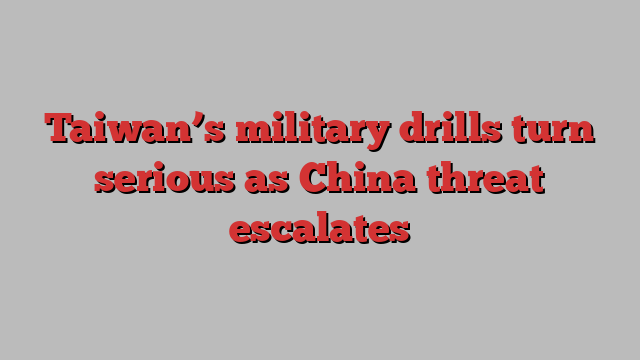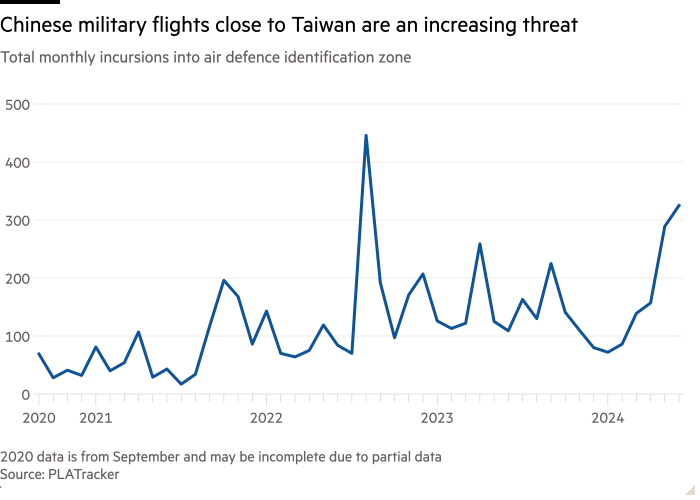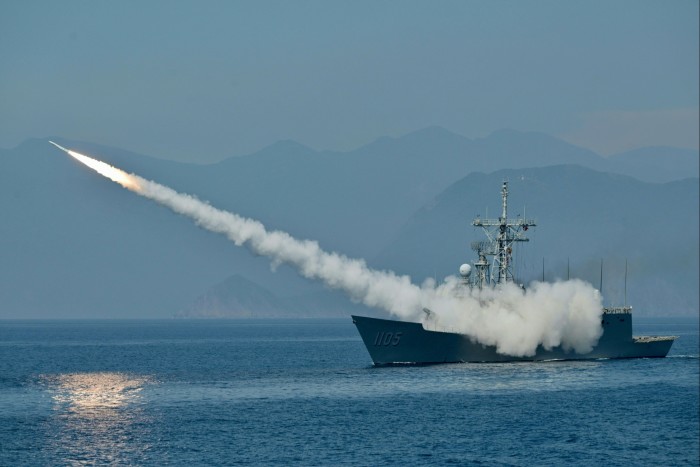
Taiwan’s armed forces will use combat exercises next week to rigorously test its warfighting capabilities for the first time, in a radical departure from decades of scripted performances as the military steels itself against the growing threat from China.
“This time, we are exercising the ability of small units to operate in the event that they are cut off from more senior command,” said a top military official, introducing the annual Han Kuang exercise. “The focus is on how to adapt, how to decide what to do, under what circumstances to engage the enemy.”
While these are standard goals for most modern militaries, the five-day drill, which kicks off on Monday, will mark a revolutionary change for the force, defence officials and analysts said.
Founded 100 years ago as the army of the Kuomintang party, the Republic of China’s armed forces, as Taiwan’s military is known, have struggled to shake off their rigid, bureaucratic culture.
“This is the first time they’re actually taking their job seriously,” said Kitsch Liao, an assistant director at the Atlantic Council’s Global China Hub and an expert on the Taiwanese military. “They feel like the situation is tense enough and are not just going through the motions like Han Kuang used to in the past.”
The drill comes amid growing tension with China, which claims Taiwan as part of its territory and threatens to attack it if Taipei resists unification indefinitely. The People’s Liberation Army is increasing operations near the island, including flying a record number of aircraft close to Taiwan this month.

Since its first iteration in 1984, Han Kuang has been the culmination of Taiwan’s annual military training cycle. With tabletop exercises and computer simulations for commanders earlier in the year, July has traditionally been reserved for a week of spectacular shows.
In the past, these have included beachfront live-fire simulations of repelling Chinese amphibious invaders. The exercises are watched by the president, other senior politicians and foreign diplomats on canopied tribunes and are broadcast live on television. To ensure a smooth performance, troops train for weeks, and soldiers are disciplined for slip-ups.
None of that will happen this year. “We are not having rehearsals beforehand, nor will there be punishment for soldiers afterwards,” said the senior military official.

Admiral Mei Chia-shu, chief of the general staff, told lawmakers last month that this year’s drill would not include a simulated enemy force because it was more important for Taiwan’s paratroopers and amphibious forces — who played Chinese invaders in the past — to train for their own crucial role in defending the country.
Mei said units would be given instructions for realistic battlefield tasks on short notice, and no live munitions would be used in Taiwan proper, as the large amount of unscripted movements would make that too dangerous.
Experts were encouraged by the revisions. “These changes begin to address the Taiwan military’s core problem, which is operational-level and tactical-level decision-making,” said Ivan Kanapathy, a former US Marine who served as director for China, Taiwan and Mongolia in Donald Trump’s National Security Council.
“Their structure is very hierarchical, almost Soviet-style. The decision [of] which hill to take was made at the colonel level instead of lower-level people evaluating the situation in real time,” said Kanapathy, who advised on military and security affairs at the American Institute in Taiwan, Washington’s quasi-embassy, 10 years ago. “Presenting them with unique problems they have not seen yet is what has been lacking for years.”
A former top general said Mei’s focus on practising decentralised command indicated the military leadership was finally embracing asymmetric warfare, a strategy that exploits a superior enemy’s weaknesses by dispersing and using small, cheap, mobile weapons instead of trying to match its strength with aircraft and big ships.
The US has pushed Taiwan to adopt asymmetry for years, but efforts to do so, spearheaded by Taiwan’s former chief of the general staff, Admiral Lee Hsi-min, were abandoned after his retirement in 2019.
Analysts said the decisive factor behind the current shift was Wellington Koo, Taiwan’s first civilian defence minister since the early 1990s save brief interludes in 2008 and 2013. Koo, a former lawyer, led the National Security Council under Lai’s predecessor Tsai Ing-wen and had closely engaged with military brass and mid-level officers.
In the two months since taking over the defence ministry, Koo has kicked off reforms aimed at reducing ceremonial and bureaucratic processes and freeing up commanders to determine strategy and training.
The space Mei has been given under Koo “is what Lee Hsi-min never had”, Kanapathy said. “He was very constrained in what he could implement in training.”
Observers also see the impact of enhanced military exchanges with the US in this year’s exercise. As more members of the US National Guard, Marines and US Army’s Security Forces Assistance Brigades have come to Taiwan to train troops and stayed for longer, they have developed a more realistic picture of the Taiwanese military’s weaknesses, said people familiar with the exchanges.
The biggest problem was the general staff’s planning process, the people said. “They have one war plan which has remained more or less unchanged for a long time, and they just assign a few people to make some quick tweaks for specific tasks,” said one person involved in the exchanges.
“That’s not how this works. They need to learn to adapt operational plans to a changing situation in wartime in rapid, live planning cycles. This exercise starts addressing that.”
Still, analysts cautioned that this year’s Han Kuang was only the first step. “People don’t realise the stage of infancy the military is in,” said Liao of the Atlantic Council. “They have to start training them to do very basic things.”